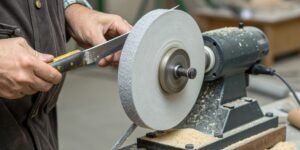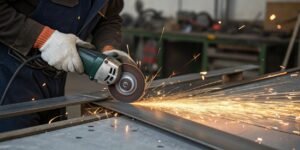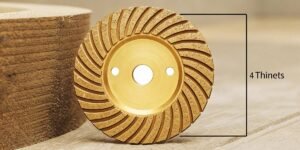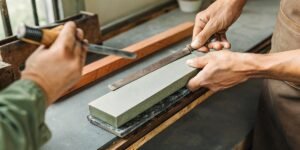
A dull chisel ruins wood and causes frustration. This wastes time and expensive materials. Learning to sharpen correctly is the simple, game-changing solution you need for clean, professional results.
The best way to sharpen chisels is by using whetstones, starting with a coarse grit and moving to a fine one. For perfect consistency, use a honing guide. A wet grinding system can also provide excellent results quickly while preventing overheating of the steel.

Now you know the basic methods. But there is more to it than just rubbing a chisel on a stone. The details are what separate a good edge from a great one. Understanding how often to sharpen, the best process for a razor edge1, what tools you really need, and the perfect angle is key. Let’s break it down so you can get an edge that lasts. This will change how you work.
How often should woodworking chisels be sharpened?
You start a cut, but your chisel is already dull again. This constant stopping kills your rhythm and efficiency. There is a simple rule for how often to sharpen.
For heavy use, a full sharpening is recommended every 2-3 hours. During general use, a quick honing or stropping every thirty minutes can maintain the edge. Always sharpen immediately if the edge becomes damaged.

The "every 2-3 hours" rule is a good starting point, but it is not set in stone. The real answer depends on what you are doing. I once spent a full day chopping mortises in hard maple for a set of custom cabinets. My chisels needed a touch-up on a fine stone almost every hour to keep the cuts clean and avoid burning out my arms. On the other hand, when I am doing delicate paring work in soft pine, I can work for half a day with just a few passes on a leather strop2 to keep the edge perfect. The type of work and the type of wood are the biggest factors. A simple way to check is the paper test. If your chisel can’t cleanly slice a sheet of paper, it is time for at least a quick honing.
Factors Influencing Sharpening Frequency
| Factor | Effect on Sharpness | Recommended Action |
|---|---|---|
| Hardwood (Oak, Maple) | Dulls edge quickly | Hone more frequently, maybe every hour. |
| Softwood (Pine, Fir) | Edge lasts longer | Strop often, with less frequent full shortens. |
| Heavy Chopping | High impact, risk of chipping | Inspect and sharpen after heavy sessions. |
| Fine Paring | Low impact, slicing action | Edge lasts a long time, strop to maintain. |
What is the best method for sharpening chisels to a razor edge?
You sharpen your chisels, but they never get that "razor-sharp" feel. This leads to frustrating work and poor results. The best method is actually a multi-step process, not a single trick.
The best method combines shaping the bevel on a coarse stone, refining it on finer stones, and then polishing on a strop. Using a honing guide ensures a consistent angle throughout this process.

There is no single "best" tool, but there is a best process. It is a system of going from coarse to fine. A truly sharp edge is not just sharp, it is also highly polished. A polished edge moves through wood with less friction. This process works with water stones, oil stones, or even diamond plates. At our factory, we know a lot about abrasives, and the principle is always the same. You need to remove material efficiently, then refine the surface. For workshops focused on high throughput, a wet grinding system3 like those from Bucktool or Wen is a fantastic choice. They speed up the initial grinding and the water cooling prevents any damage to the steel’s temper. This is critical for maintaining the tool’s quality.
Stage 1: Shaping and Flattening
First, you shape the main cutting angle, called the primary bevel4. You use a coarser stone, like a 1000-grit stone, for this. This stage does the heavy lifting and establishes your main angle. It is also when you ensure the back of the chisel is perfectly flat, which is critical.
Stage 2: Honing the Bevel
Next, you move to finer stones. A 4000-grit stone, followed by an 8000-grit stone, will remove the deeper scratches left by the coarse stone. Each step creates a more refined, sharper edge. The key here is consistency in your angle.
Stage 3: Polishing and Deburring
The final step is to use a leather strop2 with a polishing compound5. This removes the tiny burr, which is a wire of metal left over from sharpening. This final polish is what takes the edge from just sharp to truly razor-sharp.
What tools are essential for sharpening chisels by hand?
You want to sharpen your tools, but the market is full of gadgets. You worry about wasting money on things you do not need. The truth is, you only need a few essentials to achieve a professional edge.
The absolute essentials are a combination whetstone with coarse and fine sides, a honing guide to hold a consistent angle, and a leather strop with polishing compound. Water or oil is also needed.

You do not need a huge budget to get started. My first sharpening setup was very basic, but it worked perfectly. As a manufacturer of abrasives, from superhard diamonds to conventional corundum, I can tell you that the quality of your abrasive matters, but the right technique with basic tools is more important. Diamond plates are fantastic because they stay flat and cut fast, but a good quality water stone or an oil stone, like a red corundum stone, will give you excellent results. The most important tool, especially for a beginner, is the honing guide6. It removes all the guesswork and ensures you maintain a perfect angle every single time. It is a small investment that pays for itself immediately with better, more consistent results.
The Core Sharpening Kit
| Tool | Purpose | My Recommendation |
|---|---|---|
| Combination Whetstone | Main abrasive for shaping and refining the edge. | A 1000/6000 grit water stone is a versatile start. |
| Honing Guide | Locks the chisel at a precise, repeatable angle. | Essential for beginners and for consistency. |
| Leather Strop | Polishes the final edge and removes the burr. | You can even make one from a scrap of leather. |
| Polishing Compound | The fine abrasive used on the strop. | Green chromium oxide compound is common and effective. |
What is the correct angle to use when sharpening a chisel?
You hear that the sharpening angle is critical. But get it wrong, and your chisel edge will chip easily or be hard to push through the wood. There is a simple answer for this.
For most general woodworking, a primary bevel of 25 degrees is the standard. Many woodworkers then add a secondary, smaller "micro-bevel" at about 30 degrees to strengthen the edge and speed up re-sharpening.

The angle you choose is a trade-off between sharpness and durability. A lower angle, like 20 degrees, creates a very fine, sharp edge that is great for slicing soft woods. However, it is also more fragile. A higher angle, like 35 degrees, creates a much tougher edge that can withstand heavy chopping into hardwoods, but it will feel less sharp and require more force to push. This is why the 25-30 degree range is so popular; it offers a great balance for most tasks. Using a micro-bevel is a professional trick that saves a ton of time. You grind the main bevel at 25 degrees. Then, you just lift the tool slightly to 30 degrees and make a few passes on your finest stone. This creates a tiny, strong bevel right at the tip. When it’s time to re-sharpen, you only need to work on that tiny micro-bevel, which is much faster than re-honing the entire face of the primary bevel.
Understanding Primary and Micro-Bevels
| Chisel Use | Recommended Angle | Reason |
|---|---|---|
| Fine Paring (softwood) | 20-25 degrees | A lower angle for delicate, easy slicing cuts. |
| General Purpose | 25-30 degrees | A good balance of sharpness and durability. |
| Mortising (hardwood) | 30-35 degrees | A stronger edge to withstand heavy mallet blows. |
Conclusion
Regularly sharpening your chisels using the correct angles and tools is simple. This habit guarantees clean cuts, boosts your efficiency, and extends the life of your valuable tools.
-
Learn the multi-step process to achieve a razor-sharp edge for precision work. ↩
-
Learn the technique of using a leather strop to achieve a polished edge. ↩ ↩
-
Find out how wet grinding systems can enhance your sharpening process and protect your tools. ↩
-
Learn about the importance of the primary bevel angle in achieving sharpness. ↩
-
Explore different polishing compounds to enhance the final edge of your tools. ↩
-
Discover how a honing guide can ensure consistent angles for better sharpening. ↩
Written by
leeon
You may also be interested in:

How to use a hard felt bench grinding wheel on knives?
Getting a razor-sharp, polished edge on a knife can be frustrating and slow. A dull knife is dangerous, and using the wrong tool can easily

What are grinding cracks and how do you stop them?
Are tiny cracks appearing on your ground surfaces? This problem leads to part failure, wasting time and money. You can solve it by understanding the

What does an angle grinder do that other tools can't?
Struggling with tools for multiple tasks? Carrying a heavy toolbox is inefficient. An angle grinder replaces many tools, saving you time and effort on the

How to reduce the cycle time in a grinding machine?
Is your grinding process a major bottleneck? Slow cycle times hurt your bottom line and delay deliveries. You can speed up production by optimizing key

How is a grinding wheel specified?
Confused by the codes on a grinding wheel? Making the wrong choice costs money and ruins parts. Let me show you how to read them

How to sharpen wood chisels by hand?
Dull chisels tear wood, ruin projects, and waste your time. Learning to sharpen them by hand restores their precision, making your work effortless and enjoyable
